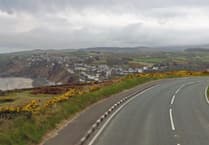What role does the built environment have to play in creating a sense of community?
Most people don’t have any input into the overall design of the towns in which they live but when you’re designing a new development – a micro town if you like – you get to consider all the elements that go together to create something that is more than just bricks and mortar.
I’ve been to see George Li and Julie Jones at Hartford Homes. George is the company’s architect and Julie Jones is its sales and lettings manager.
I want to get some idea of the thought process that goes into designing homes that, hopefully, improve people’s quality of life.
According to The National Community Survey (The NCS), a national assessment that evaluates quality of life: safety, economic health and education come top of a list of 10 key elements for creating a community. Also on the list are natural environment and built environment.
George says: ‘What we know is that, if we can make it easier for people to live a good life, in terms of energy efficiency and living in an environment which is more considerate to ecology it’s one less thing for them to think about.
‘We could build bog standard houses and plant amenity grass: people and would still have a home but it’s about quality of life.’
Hartford was founded by Alan and Angie Greenhalgh who are still very much involved in the company which is now run by their two sons, James and Norman.
Julie says: ‘We’re not a big corporate: we very much want to build a one to one relationship with our customers.’
The company currently has schemes for 550 new homes in design or planning, a quarter of which will be affordable homes. They are also engaged in the construction of a number of sites, including two very different ones, each with very different buyers in mind but both aiming to create the same sort of community vibe.
Ballagarraghyn, in Jurby, is a small development of 23 homes, a mix of two-bedroom bungalows and two-, three- and four-bedroom houses; six of them are affordable houses, eligible for Government purchase assistance schemes.
The other development is the Bay Queen, built on the site of the former hotel of the same name, which sits at the coastal end of Chapel Bay in Port St Mary. Costing ‘at least £20 million’ to build, this will offer exclusive luxury apartments with a price tag to match.
If you look at Ballagarraghyn, a lot of thought has gone into making it a greener development, as George explains: ‘What we do as standard now is install air source heat pumps and solar panels. I think it’s on the horizon now for all housing in the future but we’ve decided that it makes a lot of sense for us to do it now.’
The mix of homes is likely to attract a range of ages from young couples and families to pensioners. They all come together around a slightly unconventional green space designed to be a focal point with something for everyone to enjoy.
George explains: ‘The play area is not a standard “swings and roundabout” type of play area.
‘We worked with Isle of Play who recommended to us that children need to use their imagination in play. If you put a child on a swing, they’ll just go forwards and backwards on it but if you put a pile of large boulders they’ll jump on them and pretend it’s a castle or a mountain.
‘And we’ve got little things like raised beds so perhaps there might be a community planting in the summer. They’re accessible by wheelchairs as well so there’s an inclusive element too and you’ve got seating areas where you might see an elderly person looking after a grandchild who’s enjoying the play area.’
They also worked with Manx Wildlife Trust to provide tree, shrub and wildflower planting and create new habitats for wildlife. One of the other elements mentioned in the research about what makes a community is the natural environment. Hartford Homes are just about to plant their second ‘micro-forest’, as George explains: ‘The theory with micro forests is that they’re planted denser than you would normally expect and then they’re just left to grow and, through natural survival of the fittest if you like, the stronger ones will grow and the weaker ones will die out.
‘We sometimes we have to take trees out to facilitate development but what we understand is that young trees actually absorb more for carbon sequestration that older trees so you get a lot of absorption there.’
Permission was granted by Douglas Council to transform an area adjacent to their Farmhill Grange development into an ‘urban micro wood’. Hartford worked with Manx Wildlife Trust, who provided recommendations on viable tree species and best planting practices and they are set to begin planting more than 5,240 saplings over the next few months.
Small plantations like these grow rapidly, helping to capture carbon during growth and creating increasingly biodiverse habitats for wildlife to thrive in urban environments.
‘For us, it’s doing the little things that all add up,’ says George.
Another thing to consider with a new development is the impact it has on the wider community nearby.
The Bay Queen development, when completed, will have 37 flats, all occupied by people wealthy enough to buy one of these properties. It’s not hard to imagine the positive effect this will have on the local economy in Port St Mary and the south generally.
George envisages the possibility of it not only increasing trade for existing retailers and cafes in the area but also being the catalyst for more new businesses opening.
Taking an even wider view, this also supports the government’s plan to increase the population and the Bay Queen is already attracting off-island interest.
Julie Jones says: ‘We have had enquiries from all over the world, including America, and reservations through Facetime and virtual viewings from every part of the world.’
Which brings us on to the current media preoccupation, certainly in the UK, that we are entering a period of property market gloom. Is the outlook the same on the island?
George doesn’t think so. He says: ‘I think the island market is different. The government in the island have really been proactive – you can see that population growth is the aim and economic growth is the aim, and that will highlight that more houses will be required.’
Julie adds: ‘It’s very steady: generally December is a quieter month but we have still been very busy. For us it’s moving on to the next stages because nearly everything we’ve got is sold: the demand is running higher than we can supply at the moment.’
She adds: ‘At the end of the day we’ve all got to live somewhere.’




